|
FAQs about Marine Snail
Identification 24
Related Articles: Gastropods, Sea Slugs, Mollusks, Abalone,
Related FAQs: Snail ID
1, Snail ID 2, Snail ID 3, Snail
ID 4, Snail ID 5, Snail ID 6, Snail
ID 7, Snail ID 8, Snail ID 9, Snail ID
10, Snail ID 11, Snail ID 12, Snail
ID 13, Snail ID 14, Snail ID 15, Snail ID
16, Snail ID 17, Snail ID 18, Snail ID
19, Snail ID 20, Snail ID 21, Snail
ID 22, Snail ID 23, Snail ID 25, Snail
ID 26, & Marine Snails 1,
Marine Snails 2, Marine Snails 3, Invertebrate ID, Snail Behavior, Snail Selection, Snail Compatibility, Snail Systems, Snail Feeding, Snail Disease, Snail Reproduction, Mollusks, Sea
Slugs, Abalone,
|
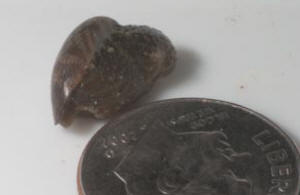
|
|
Invertebrate ID Opisthobranchia? Stomatella
8/5/10
I found this creature in a 14Gallon bio cube. There were actually
3 of them in the tank. Any ideas?
<Please read here: http://wetwebmedia.com/LimpetID1.htm
Bob Fenner>
|
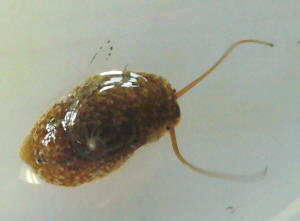 |
|
What Is My Snail Doing? Sudden Influx of Snails,
Possible Reproductive Event - 6/24/10
Hello to all!
<Hello Alice, Lynn here today!>
I recently had a massive snail explosion, woke up one day and
there were hundreds of tiny baby snails all over my 30g tank.
<Neat!>
I have been picking them off every few days and throwing them
away.
<Say it isn't so! Why not give them away to local
hobbyists, sell, or even them trade for livestock/products at
your local fish store?>
(I think they are Turbos) My question is what is my snail doing??
It doesn't look like the pictures of snail eggs... is it
dying and spewing sand?
<I don't think so, no. How is the snail doing today? It
could have shed some sort of mucus or released/deposited a
gelatinous egg mass while positioned on the glass and then fell
over somehow. Whether mucus or gelatinous, the substance would
likely have become imbedded with sand grains. It's also
possible that the snail simply crawled across a patch (of
who-knows-what on the substrate) that once grasped by the foot,
separated from the underlying sand and caused a loss of traction.
At that point, the snail probably fell over trying to gain
purchase and ended up with the patch stuck to its foot in the
position seen in the photo. By the way, can you still see any
evidence of this clump/mass? As for the 'babies', their
sudden appearance does sound like some sort of overnight hatching
event, but I'd need to see a photo of one as well as a list
of resident snail species in order to confirm and/or determine
where they came from. We also need to rule out Collonista snails,
also known as 'Mini-Turbos'. They're mostly
nocturnal, beneficial herbivorous hitchhikers often mistaken for
juvenile Turbos. Depending on the species, they can reach
~1/4' across but most measure 1/8' or less. For more
information on these and a photo for comparison, please see the
FAQ titled 'Need an ID on a snail: Collonista sp. -
1/5/08' at the following link: http://www.wetwebmedia.com/snailidf14.htm
.>
Thanks in advance
<You're very welcome.>
Alice
<Take care, Lynn Z>
|
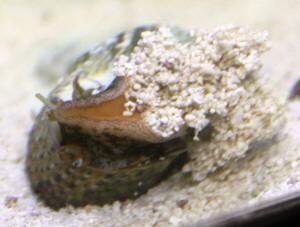 |
|
Re: Unknown Critter ID? Snail: Marginellid,
Volvarina sp. -- 8/24/10
<Hello Penny, Lynn here this evening.>
Here are a few more pictures of my mystery snails.
<Thank you, I think we have a winner!>
I have no idea where they came from as they were
hitchhikers off a coral a customer brought in.
<That's okay. Now that I've gotten a better look
at them, I can tell you that they're Marginellids
(family Marginellidae -- aka 'Margin' shells) in
the genus Volvarina. They're small (typically ~5 -16
mm), but potentially fast-moving predators and scavengers,
that have beautifully shiny, somewhat translucent shells
with no operculum (trap door). As far as what they eat, I
haven't read anything about them preying on corals,
just molluscs (definitely snails and perhaps small
bivalves). Please see the following links for various
species. Just bear in mind that each can vary to a
surprising degree. See Volvarina spp. starting about
half-way down this link:
http://www.gastropods.com/Taxon_pages/TN_Family_MARGINELLIDAE
MARGINELLINAE_PRUNINI.shtml
More here, showing live individuals:
http://www.poppe-images.com/?t=33&search=volvarina&p=1
.>
Found under star polyps that are attached at the base of a
Sinularia. I'm concerned that they might be parasitic
but do not see any damage to either coral.
<They do tend to congregate, but I think the fact that
they were near the corals was more than likely incidental.
They may have been taking refuge as a result of being
stressed after the move, or perhaps they're nocturnal,
and were simply waiting for the lights to go out.
Unfortunately, there's not a whole lot of detailed
information on the genus so I don't know when
they're most active. What's important is that at
least you know not to mix these snails with other
molluscs!>
Penny Harkins
<Take care, Lynn Z>
AquaCorals - Saltwater Reef Aquariums
www.AquaCorals.com
|
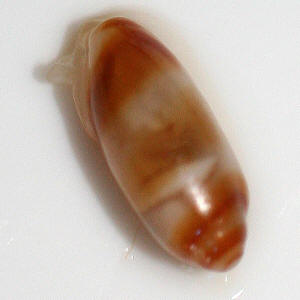 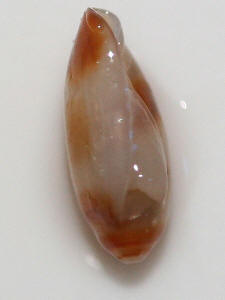 |
Re: Follow-up Re: Unknown Critter ID
Snail-Marginellid, Volvarina sp. - 8/25/10
<Hi Penny!>
Thank you so much for the ID & information.
<You're very welcome.>
Wow. I didn't realize the genus was so huge!
<Yep, that's why knowing where the snails come from is so
important. Thankfully though, for our purposes, knowing the
family and genus is enough for us to figure out what sort of
threat they pose. Another factor that makes identifying this
genus a challenge is the translucent/almost transparent quality
of their shells. They allow the underlying (sometimes
patterned/colored) soft tissue to show through, which can really
throw you if you're making comparisons to empty shells. Then
there's the variation in color within each species. It can be
a real challenge alright!>
Even having them in person I can't positively ID the specific
one.
<I can certainly understand that. You'd actually need to
see live specimen photos of every single specie and its
variations to have the best chance at an ID. Unfortunately, I
know of no such internet link/site.>
Either way, my biggest concern is having them in my systems. Do
you know of any fish that will eat them or any way to eradicate
them from reef tanks?
<Well, as far as snail-eating fishes, the ones that come to
mind first are puffers, triggers, some wrasses, groupers, and
Hawkfishes. It just depends on the size of the fish (and snails)
and how hungry they are. There's also the potential issue of
when the snails are active. If they're mostly nocturnal, the
fish(es) may never see them or know they're there. Another
possibility is another, larger, predatory snail, like Oliva
sayana (the Lettered Olive) from the Gulf of Mexico. The problem
with that choice is that you'd be trading one problem for
another. Personally, I'd go for manual removal. Since
Volvarina spp. are scavengers as well as predators, you might try
leaving a bit of shrimp, clam, etc., on the substrate. Hopefully,
they'll merge on it (or at least come out of hiding) and you
can collect them. If that doesn't work during daylight hours,
wait until after the lights are out and try again. Hopefully,
that'll do it!>
Penny Harkins
<Take care, Lynn Z>
Re: Re: Follow-up Re: Unknown Critter ID
Snail-Marginellid, Volvarina sp. - 8/25/10
Thank you again Lynn.
<You're very welcome.>
I truly appreciate your time & expertise.
<It was a pleasure, Penny, and a good learning opportunity for
us both.>
I will be sure to pass on the love. :c)
<Much appreciated!>
Penny Harkins
<Take care, Lynn Z>
AquaCorals - Saltwater Reef Aquariums
www.AquaCorals.com
|
|
Zoanthid eating snails?
Hi Guys,
<Jorge>
I just finished searching many forums and reading through a lot
of your site.
Over the last month, I lost various Zoanthid colonies of mine.
The colony slowly but surely starts to develop a white film and
then just disintegrates (which I know is typical of infection
but...). Once I noticed this, I fragged away any healthy polyps
as best as I could and those for a while did well, but then also
withered away (over a week or so)
I also dipped the colony in CoralRx but that was to no avail as
it continued to disintegrate. While I was fragging away some more
healthy polyps, I noticed that the colony had hundreds, or even
thousands, of these little tiny balls. I am guessing they are
some sort of egg as the balls have a mucus like substance that
keeps them together when you try to pull them off the coral. In
other words, if you pull a tiny cluster of the balls away, quite
a few more little clusters follow behind it.
Sure enough, as I started to pull the "eggs" off the
colony, under the "eggs" I found various snails. I am
not sure what they are, but I am guessing they are the culprit.
Hopefully the pictures are good enough.
I would really appreciate it if you could tell me what the heck
these things are and if you think they are guilty. And then what
I need to do to get rid of them. The CoralRx seems to have done
nothing to stop them.
Thanks so much for all the information you provide us reefers. It
is greatly appreciated by me and many others.
Take care,
Jorge
aka - Jgoal55 on RC.
<Do look like predatory snails... Please read here:
http://wetwebmedia.com/zohlthf3.htm
and the linked files in the series above, and:
http://wetwebmedia.com/pestsnailfaqs.htm
Bob Fenner>
|
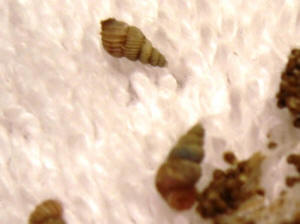 |
|
Snail Identification: Predatory Murex or Triton --
4/18/10
<Hello, Lynn here today.>
I purchased this at the LFS today along with some other critters.
Has a very neat shell.
<Yes, it does.>
Anyways it also has two anemones attached to it.
<Hopefully they're not of the pest variety!>
What type of snail is this?
<It looks like some sort of Murex (family Muricidae), possibly
a common Apple Murex, Chicoreus pomum. Another possibility
though, is a species of Cymatium (family Ranellidae), otherwise
known as a Triton. If you could send me a good close-up photo of
the side of the shell with the opening (need a direct shot of
that opening), I could tell you which one you have and give you a
bit more information. Murex and Triton snails are beautiful but
predatory. Apple Murexes prey on oysters and other bivalves, but
will also prey on other snails as well as barnacles. Tritons prey
on Mollusks (including snails and bivalves) as well as
Echinoderms (including sea stars and urchins). Although either
group would be very nice in a species tank, I wouldn't advise
keeping them in a reef system including any of the above prey
items.>
The owner said it is from the Gulf of Mexico.
<That's helpful, thanks. Please see the following links
for examples of both groups of snails from this region:
Murex: http://www.gastropods.com/6/Shell_1416.shtml
Triton: http://www.gastropods.com/0/Shell_11140.shtml
Again, please send along another photo (or several) if you'd
like to pursue the ID.
Take care, Lynn Z>
|
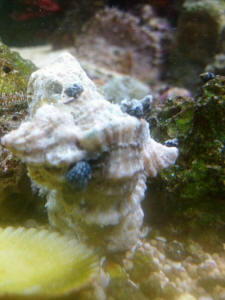 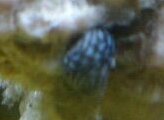 |
|
Something Growing on My Rock? Snail Egg Casings --
4/11/10
<Hello Bill, Lynn here today.>
I have a 90 gal salt tank 1 large lion-fish, 1 large eel (yellow
with black dots), 1 large black pointy sea urchin, 4 conch
snails,
<Do you know what variety/species?>
..many Mexican turbo snails, 1 brittle starfish, 1 chocolate
starfish, about 80lbs of rock, water tests good most of the
time.
<Need to aim for all of the time!>
I use a 1200 gph pump with overflow to sump containing miracle
mud and mangroves and a canister filter and turbo twist UV light
and a water chiller for temp with average 78 degrees. Can you
identify what these things are growing off my rock see
picture!
<Yep, they're snail egg casings, possibly left by a
Melongenid (Family Melongenidae), which includes species commonly
referred to as Conchs and Whelks. The casings you have are
definitely not from a Fighting Conch (Strombus alatus or Strombus
pugilis), or a Queen Conch (Lobatus/Strombus gigas), all of which
are in the Family Strombidae. Their egg masses resemble an
amorphous tangle of gelatinous string embedded with sand. Please
see the following links for examples:
Strombus alatus (aka the Florida Fighting Conch): http://www.jaxshells.org/1562anne.htm
Strombus pugilis (aka the West Indian Fighting Conch): http://www.jaxshells.org/1540anne.htm
Here's an example of a Melongenid's egg casings,
specifically Melongena corona (aka the Crown Conch). They're
a bit more rounded than the ones you have, but you can see the
similarity (and they do vary): http://www.jaxshells.org/mcegg3.htm
Here's another Melongenid example, the Channeled Whelk
(Busycotypus canaliculatus). Busycotypus/Busycon species'
casings are similar but usually have a bit more surface texture
(not as smooth): http://www.turtlejournal.com/?m=201002&paged=2
By the way, it looks like you have a nice little population of
beneficial Collonista snails, aka 'Mini-Turbos', roaming
the rocks! You can find more information on these at WWM. Just
enter Collonista in the Google search engine:
http://www.wetwebmedia.com/Googlesearch.htm >
Thanks Bill V
<You're very welcome. Take care, Lynn Zurik>
|
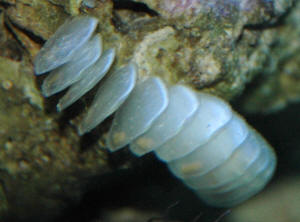 |
|
Re: Something Growing on My Rock? Snail Egg Casings --
4/12/10
<Hi Bill>
Thank You !!
<You're welcome! Lynn Z>
|
Black Onyx Nassarius Snails: Buyer Beware: Likely Ilyanassa
obsoleta -- 3/29/10
Hello.
<Hello Michelle, Lynn here tonight.>
Hope this email finds you all in good health!
<It does indeed, thank you. I hope that you're enjoying good
health as well!>
I have a question on Nassarius snails, and can only find notes on WWM
regarding Whelks or Tongans- I am needing some info on black onyx
Nassarius snails.
<Hmmm, the snails I've seen sold on the net under this common
name appear to be Ilyanassa obsoleta (aka the Eastern Mud Snail), an
extremely common, cooler water snail that's not at all suitable to
the higher temperatures of reef systems. Their range includes the
western Atlantic, from Canada to northern Florida, as well as the west
coast of North America from British Columbia to California. Neither
range could be considered tropical! Exposing these snails to long-term
higher temperatures speeds up their metabolism, resulting in
drastically shortened lives.>
Is there a link here that you can provide?
<Yes, please see the following link for photos of Ilyanassa obsoleta
(for comparison): http://www.gastropods.com/5/Shell_3305.shtml
More information re: http://reefkeeping.com/issues/2006-11/mg/index.php
>
Or can you answer for me: Are they reef safe? To the extent that they
will not disrupt and devour my copepods?
<Apparently, they're mostly deposit feeders and scavengers that
feed on organic detritus, microorganisms (diatoms, bacteria, BGA,
etc.), some macroalgae, and carrion. Any critter than scavenges though,
has the potential to venture into live foods if it gets hungry enough
and the opportunity presents itself. The studies I've read
regarding the diets of wild individuals seem to indicate that live
fauna is not a significant part of their diet at all. However, it's
possible that an omnivorous snail with a boosted metabolism and
appetite, might indeed go after whatever prey is most readily
available. There have been reports of these snails attacking other
snails and there is some concern regarding the possibility of them
depleting beneficial sand-bed fauna.>
I have a mandarin goby and a scooter blenny- so want to make sure they
still have their food supply.
(Tank size: 180 gallon mixed reef)
<I would avoid these snails. No matter what they eat, they're
ill-suited to life in a reef system. If you need a scavenger that will
help stir the sand a bit, I'd go with something like the commonly
available Nassarius vibex. They're terrific little snails that
erupt en masse out of the sand at feeding time.>
Any info you can give is appreciated.
Thank you.
<You're very welcome. Please let me know if there's anything
else I can do for you.>
Michelle
<Take care, LynnZ>
Re: Black Onyx Nassarius Snails: Buyer Beware: Likely
Ilyanassa obsoleta -- 3/30/10
Thank you, Lynn.
<You're very welcome, Michelle.>
Here is a copy of the listing, stating reef safe: I appreciate you
getting back with me last night- thank you for the information.
<It was a pleasure. If the company is indeed selling I. obsoleta as
a reef snail, that's a real shame, but sadly not all that
surprising. These and other temperate-water snails like Margarita
snails/ Margarites pupillus, Red Foot Moon Snail/ Norrisia norrisii,
etc., have been offered in the trade for years to reef hobbyists.
I'm glad to see that some companies are now listing (and commenting
on) the lower temperature requirements, but others are not quite up to
speed on this. Perhaps they are simply unaware. Once again, it serves
as a reminder to all to research before bringing home, and I commend
you for doing exactly that! I received a small number of Ilyanassa
obsoleta snails years ago from a large online company in lieu of the
Nassarius vibex that I had ordered. I didn't have any problems with
them attacking other snails, but perhaps they found enough food
elsewhere around the tank. Sadly, all were dead within 6
months.>
Have a great day and a Happy Easter! (if you celebrate)
<I do, thank you very much! Happy Easter to you as well!>
-Michelle
100 Onyx Nassarius Snails
<Yep, in cases where only a common name is offered, always inquire
about the scientific name. Only then can you really research and find
out if the animal is appropriate to your situation.>
100 Saltwater Reef Safe Nassarius Snails Coral Cleaners
<Was this supposed to describe the Onyx Nassarius Snails listed
above? If so, and if they're selling I. obsoleta, then yes they are
'reef safe' to an extent. The problem is that the term is a
very general one with many interpretations. Some see it as an
indication that an animal won't eat corals, others, that it
won't eat their snails, fish/livestock, and still others see it as
an indication that the animal won't release toxins either when
stressed or upon death. The list goes on and on. I daresay you'd be
surprised how many different answers and combinations you'd get if
you asked hobbyists what the term 'reef-safe' meant to them.
There is no single correct answer. In the case of Ilyanassa obsoleta,
the term may indeed seem applicable to some, but not to me personally.
At any rate, no matter how you interpret it, these snails are not
suited to the long term higher temperatures of reef systems. So, is it
reef-safe - maybe. Is it reef-suitable - no!>
The Most Bang for your Buck
<Mmm, no comment>
Total 100 Snails!!! The Nassarius snail is a small scavenger with an
oval spiral shell that resembles an olive pit, with a long tube like
siphon that protrudes from the end of the shell. One of the most ideal
scavengers and detritus eaters these snails are perfect for the reef
aquarium, quickly consuming detritus, uneaten food, decaying organics,
and fish waste. Nassarius snails like to bury themselves in the sand,
which will help maintain adequate oxygen levels in the substrate.
Shipped without water.
Check out my other items!
Be sure to add me to your favorites list!
<Mmmm, no comment here, either. Take care, Michelle. Thanks once
again for researching before buying! LynnZ>
|
Unknown Thing Growing on Glass: Snail Egg Capsule --
3/14/10
Dear Crew,
<Hello Justin, Lynn here this evening.>
Can you guys help me out with what this is?
<Yes, it's a neat little egg capsule that looks very much
like those left by Nerite snails. They're typically white (or
whitish), oval to round in shape, around 3mm or so in length, and
deposited either singly or in groupings on hard surfaces.>
They look like eggs of some sort, but I have never seen anything
like it. They are quite small, a little larger than the end of a
ball point pen.
<Since you said 'they', I'm guessing that you mean
the individual eggs inside, not the capsule itself. If that's
the case, then it's consistent with Nerite
capsules/eggs.>
I tried my best with the macro lens, but this is the best I could
get.
<You did very well, thank you! For more information/photo,
please see the following link:
http://www.advancedaquarist.com/issues/sept2003/invert.htm
By the way, if you do not have any Nerite snails in residence, do
send along a list of what snails you have and we'll see if we
can't figure out who the culprit is!>
Thanks all
<You're very welcome.>
Justin
<Take care, LynnZ>
|
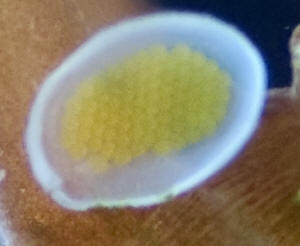 |
|
Re: Unknown Thing Growing on Glass:
Snail Egg Capsule, Nerite -- 3/14/10
Thanks LynnZ,
<It was a pleasure, Justin.>
Actually though the capsules themselves are only about the size
of the end of a ballpoint pen.
<That's pretty small but not beyond the realm of
possibility. The Nerite egg capsules commonly reported to us tend
to be larger, but they can vary according to species. For
example, Nerita tessellata (aka the Checkered Nerite) from
Florida reportedly has capsules that are only about 1mm in
length. Please see the following link for more
information/comparison:
http://www.sms.si.edu/irLspec/Nerita_tessel.htm >
I do have 3 Nerite snails left in the tank,
<I believe we have a winner!>
..some Trochus,
<It wouldn't be these snails. They're broadcast
spawners. That is, they release gametes (eggs/sperm) directly
into the water column (no egg capsules).>
..and I seem to have a breeding colony of Elephant snails as
well
<I'm guessing you don't mean the giant African land
snail (genus Achatina)! That's the problem with common names;
they're common as opposed to specific. Sorry to give you a
hard time but I just couldn't resist. I blame it on losing an
hour of sleep last night to the Daylight Savings Time switch. I
really need to move to Hawaii, where they don't mess with the
time twice a year! Anyway, back on topic, the terms 'Elephant
snail' and 'Elephant slug', are also used in
reference to Scutus spp. snails (black, slug-like snails in the
family Fissurellidae). If that's what you have, then we can
rule them out as well. Like the Trochus snails mentioned above,
they're spawners. See this link for more information/photos:
http://www.seaslugforum.net/showall/scutus >
..(I say this because every few weeks it seems as if I find
another small one (1/4" or so) crawling along the glass.
<Neat! Apparently, their survival rate in captivity is aided
by the fact that they go through a non-feeding, planktonic,
larval/'veliger' stage before metamorphosing into
crawlers. Non-feeding veligers tend to have shorter planktonic
stages than those that need to feed. The advantages are two-fold.
First of all, less time in the water column equates to less
chance of becoming food for fish, corals, etc., or perishing
within/as a result of pumps, filters, etc.. Also, the fact that
they don't need to feed gives them a distinct advantage over
those that require specific planktonic foods (that may not be
available in a captive system).>
It seems as I might have some pyramid snails attacking my other
snails though, since they have these tiny white conical shaped
snails hitching a ride, and starting to attach around the shell
opening by the foot.
<Hmmm, are the snails long, slender, and mobile, or
short/squat and sessile? If they're long, slender and mobile,
you're right, they're most likely 'Pyrams'
(family Pyramidellidae) and you'll need to get rid of them
(see WWM re: methods). The fact that they're gathered around
the foot/opening is typical of these pests. If the snails
you're seeing are short, squat and sessile, they could be
Hipponicids (aka 'Hoof snails'). These are roughly
conical, Limpet-like snails that begin life as mobile crawlers,
but eventually become sessile; attaching themselves to hard
surfaces (including snail shells). Luckily, they don't
actually prey on the snails they're attached to, but it's
possible that as they increase in size, they could inhibit the
snail's ability to move around and/or feed. Here's a link
with some terrific photos for comparison:
http://www.conchology.be/?t=65&family=HIPPONICIDAE
Hipponicid on a snail shell (see the FAQ titled 'Mollusk
Identification - Hipponicids 06/20/08'):
http://www.wetwebmedia.com/snailid16.htm >
What a pain it is to deal with that....darn pests!!
<Yes, indeed!>
Other than that, that would be it. Thanks again for the help, I
appreciate it.
<You're very welcome, please let me/us know if there's
anything else we can do for you.>
Justin
<Take care, LynnZ>
|
|
Snail ID: Predatory/Scavenging Whelk --
2/12/10
Hello,
<Hello Mike, Lynn here this evening.>
I searched through all the snail ID posts but couldn't find
anything that I thought to be an exact match. I would like an ID
of this hitchhiker snail I acquired yesterday.
<It's a Whelk, family: Buccinidae Pisaniinae.>
I'm going to assume it's not a welcomed snail as I came
home to find it attached to one of my Astraea snails. I quickly
separated them and quarantined the hitchhiker.
<Good>
Here is a picture.
<From what I can see, your little snail looks very much like a
predatory Whelk known as Gemophos tinctus, aka the Tinted or
Painted Cantharus. Information can also be found on the
'net/elsewhere under several obsolete names, including Pollia
tincta and Cantharus tinctus. These snails prey mostly on fellow
Gastropods and Bivalves, but also scavenge and can get up to
about 1.25' in length. You did the right thing in getting
that little guy out of there! For more information/photos for
comparison, please see the following links:
http://www.jaxshells.org/gtinc.htm
http://www.gastropods.com/8/Shell_3228.shtml >
I would be glad to send more photos if needed for proper ID.
<Thanks. If what you have doesn't seem to be Gemophos
tinctus, and you'd like to pursue an ID, please send along a
photo (or several) showing the other side of the snail, as well
as location of origin (if known). If the snail hitchhiked on
rock, etc., from around Florida or the Gulf of Mexico, chances
are good that it's G. tinctus. It's a very common
species. I've gotten at least several with every live rock
order I've placed from Florida. Here's a photo of the
last one I received:
http://bb.wetwebmedia.com/gallery/viewpic.php?pic_id=391 .
All in all, they're beautiful little snails, but
unfortunately not so great in a mixed reef system.>
Thank you!
<You're very welcome!>
--Mike
<Take care, LynnZ>
|
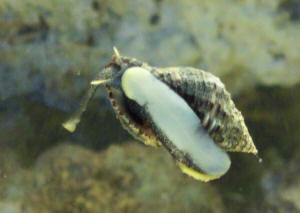 |
|
Re: Snail ID: Predatory/Scavenging
Whelk -- 2/13/10
<Hello Mike!>
Thank you very much!
<It was a pleasure.>
That's about what I figured. I looked at one of the pictures
in the first link you provided and it looks exactly like what I
have.
<Yay! By the way, I was able to find a bit more information
specifically related to the diet of G. tinctus (as opposed to
Whelks in general). Apparently, their prey of choice includes
mostly sessile invertebrates such as barnacles, tube-dwelling
Polychaetes, Vermetid Gastropods, and the like. I can tell you
from experience however, that they will also prey on other
Gastropods. The bottom line is that these snails are carnivorous
predators and scavengers that when hungry enough will go after
whatever food they can find/eat.>
Thank you once again!
<You're very welcome!>
Cheers --Mike
<Take care, LynnZ>
PS: It did come attached to a live rock that I just
purchased.
<Yep, that's typical.>
|
Snail Confusion: Astraea, Turbo Classification Issues --
2/3/10
Hi,
<Hello Rebekah, Lynn here today.>
I am interested in adding snails to my tank.
<Alright!>
I have a 55-gallon tank. It's been up and running for approximately
18 months and started out as a FOWLR but I'm slowly and steadily
making my way into inverts.
<Slow is good.>
Two peppermint shrimp (Lysmata wurdemanni) were the first invert
inhabitants and so far so good.
<Excellent>
So back to my snail question. I would like to get snails to eat algae
in my tank.
<You mean the green film algae that tends to build up on the tank
sides/walls, not a macro-algae, right? Or do you need the snails for
something else?>
I have been reading about many different snails. Lots of info I read
says that Turbo snails are excellent for algae but can knock things
around while bulldozing through your tank.
<The really big ones can occasionally, yes. They also have a big
appetite and can quickly go through the available food supply and
starve to death. The good news is that most will accept dried
seaweed/Nori sheets to supplement their diet. This can be offered via a
suction cup clip attached to the glass near the snail. You should be
able to find seaweed sheets either in the grocery store or at your
local fish store. Suitable clips, sometimes called "Veggie
clips" should be available at your local fish store as well, or
online.>
I don't think I want that, so I kept reading. Then I was reading
about Astraea snails.
<Love 'em.>
From what I read they are good with algae,
<Yes, they are.>
..stay smaller,
<Well, the common Astraea/Lithopoma tectum snails can get up to
about 2.5'. Six years ago I received an 1/8' juvenile, with a
live rock order, that's now pushing 2' top to bottom.
Thankfully, he doesn't seem to do any noticeable rearranging,
though.>
..but can't right themselves if they flip over. That sounds good,
I'll just keep a close eye on them in case they go bottoms up.
<Yes, as with all other livestock, it's always a good idea to do
a daily check.>
Then, here's where my confusion comes in...as I have been reading
more and more about these two snails, I have seen many references to
Astraea snails, Turbo snails, Astraea Turbo snails, and even Turbo
snails, genus - Astraea, species - tectum (or other). So is a Turbo
snail an Astraea snail (or the other way around)?
<Heee! Neither! Perhaps some of the confusion stems from the fact
that both are in the same Superfamily: Turbinoidea (aka
'turban' snails) and family: Turbinidae. It could be that
people are interchanging Turbinidae with Turbo. Beyond family level,
the two snails part ways into two subfamilies. The standard/commonly
offered Mexican Turbo snail (Turbo fluctuosus) is in the subfamily
Turbininae, while 'Astraea' (old name: Astraea tecta, now
Lithopoma tectum -- sometimes 'tecta') snails are in the
subfamily Astraeinae.>
I just want to make sure I know what I want and know the right
questions to ask at the LFS.
<Smart gal! If you have a lot of algae, you could try a small Turbo
and a couple of Astraea/Lithopomas and see how it goes. If you just
have a small amount, I'd skip the Turbo and go with a couple of
Lithopomas. Again, slow is good. You can always add more later on, if
desired. You'll still have to clean your tank sides regularly
though. If you bought enough snails to completely clean everything,
they'd soon starve to death, so don't fall victim to someone
telling you to buy at least 30 or 40 snails! As far as determining
which snail is which, look for general shape. Turbo fluctuosus has a
fuller, more rounded overall appearance while Lithopoma tectum has a
comparatively straight, more triangular profile. One thing I'd like
to mention, just in case, is that various species of Trochus snails
(Superfamily: Trochoidea, family Trochidae) are also commonly offered
in the trade (for algae consumption) and can be easily confused with L.
tectum. Some hobbyists swear by these snails, but I personally
haven't had much experience with them. The Trochus spp. we normally
see offered tend to have straighter, less knobby, sides than L. tectum.
Some also have an almost beaded surface texture and are beautifully
banded with color. If you're at all unsure, and specifically want
one variety of snail over the other, check the snail's operculum
(the trap door at the opening of the snail). Lithopoma snails have an
unmistakably thick, calcareous operculum (looks stony), while Trochus
snails have a thin proteinaceous/'horny' one that's
flexible and often amber to brown in color. Whichever snail you decide
to get, be sure to choose only those that are actively feeding or at
least up on the rocks/glass. Pass on any individuals just laying about
on the substrate. Please see the following links for examples of the
snails mentioned above. Just bear in mind that there can be variations
in color and degree of ornamentation within a given species. Otherwise,
the overall shape should be the same.
Turbo fluctuosus, the commonly offered Turbo snail (see whitish, thick
operculum): http://www.gastropods.com/3/Shell_2443.shtml
Lithopoma tectum, commonly offered as Astraea snails (thick, whitish
operculum): http://www.gastropods.com/0/Shell_1790.shtml
Trochus radiata, aka the banded Trochus (see thin amber operculum):
http://www.gastropods.com/9/Shell_2259.shtml >
I haven't been able to find a definitive answer. Too bad we
can't just all use the Latin names and avoid the nomenclature
confusion.
<It can be maddening, I know. Hopefully the above information will
help. Please let me know if there's anything else I/we can do for
you. If not, good luck with the new snails!>
Thank you for the clarification. Rebekah
<You're very welcome. Take care, LynnZ>
Re: Snail Confusion: Astraea, Turbo Classification Issues --
2/4/10
Thank you, Lynn.
<You're very welcome, Rebekah.>
To answer your question, I am interested in snails to eat the film
algae from the glass. So, your answer is perfect.
<Oh good.>
I feel like I'm back in Zoology 101!
<Me too, I'll save you a seat!>
Thanks!!
<You're welcome, enjoy those snails! Take care, LynnZ>
|
Help Me Identify This Snail: Stomatellid --
1/26/10
<Hello Nick, Lynn here today.>
I discovered this little guy crawling around the back corner of
my tank last night.
<Neat>
Any ideas on what it is and where it came from.
<It's a pretty little Stomatellid (probably Stomatella
varia) that most likely originated in the Western Pacific.
They're common, harmless/beneficial herbivorous grazers in
the family Trochidae. For more information, please see the
following links:
http://bb.wetwebmedia.com/viewtopic.php?f=25&t=181
Be sure to Google WWM for a veritable boatload of FAQ's re:
http://www.wetwebmedia.com/Googlesearch.htm
Photos of Stomatella varia:
http://www.gastropods.com/2/Shell_2422.shtml >
I had never seen it before. Thanks for all the info and service
you all provide.
<You're very welcome and thank you!>
Nick
<Take care, LynnZ>
|
 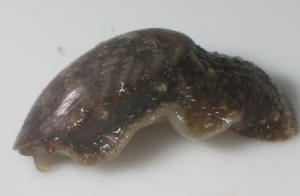 |
Help with identifying unknown snail?? Invert., SW...
1/25/10
<Hello Blaire, Lynn here today.>
I've had my aquarium for about 6 months now. About 2 months ago I
bought some live rock from someone who was parting out their tank.
Needless to say I brought in all sorts of new life forms.
<Neat>
There were a bunch of tiny pretty snails, pods, bristleworms, even some
neat looking mini anemones I couldn't identify that my Klein's
has since ate. (They weren't Aiptasia). There's one thing I
can't seem to identify though. It's about 3/4", slightly
more oblong than round, and very dark blue in color. If the light
isn't directly on it, it looks black. It does not have an actual
hard shell, and I can only say "snail" because it has a
snail's head with antennas. The "shell" is soft and
flexible (like the body of a ray), and it is very slow moving. I
can't really get a pic of it as I only see it a couple times a week
and it's always between rocks, never out in the open. Any help you
can give me would be greatly appreciated!
<Hmmm, there are many possibilities. An animal with antennae but no
visible shell could be some sort of sea slug, Nudibranch, Polyclad
flatworm, or even a Scutus unguis (aka the 'Ducksbill Limpet').
Soft and ray-like sounds more like a flatworm or some sort of slug or
Nudibranch, rather than a Scutus spp. but it's worth looking into.
Scutus unguis actually has a white shell, but it's usually covered
by the animal's deep black mantle. It's possible that under
certain lighting, the flexible black mantle could appear bluish.
I'm sorry I can't be more helpful but there are just too many
possibilities. Here are some links that will hopefully help narrow
things down a bit.
Nudibranchs: http://www.wetwebmedia.com/nudibran.htm
Sea Slugs: http://www.wetwebmedia.com/seaslugsopisthobranchs.htm
Polyclad Flatworms (see Pseudoceros sapphrinus):
http://www.wetwebmedia.com/WormPIX/FlatwormPIX/Flatworms2.htm
Scutus Unguis: http://www.seaslugforum.net/showall/scutus
Please let me know if you need any additional help. I know a picture
sounds impossible, but if you get lucky, send it along!>
Thank you, Blaire
<You're very welcome. Take care, LynnZ>
Re: Help with identifying unknown snail?? Scutus Unguis -
1/25/10
Hi Lynn,
<Hi Blaire.>
Thank you so much for your help!
<You're welcome!>
I looked it up and it's a Duckbill Limpet.
<Neat little creatures.>
All the little life forms that pop up are such treasures and I make it
a
point to find out what they are and what their needs are. Maybe you
could answer one more question for me? I have a Harlequin shrimp (what
a beauty!) and would like to know if there is anything I could add to
my tank that would dispose of the leftovers of the starfish he eats?
I've asked my LFS guys and they say my clean up crew should take
care of it but they don't. These little white pieces are adding up
quick and I can't get to them to siphon them out. Any
suggestions??
<If you don't already have hermits, I'd recommend getting
some Nassarius snails. They're terrific little scavengers that stay
hidden within the substrate then erupt en mass when they smell food.
They also have the added advantage of stirring the sand up a bit as
they move around. You could try either Nassarius vibex, a small species
(usually less than 1/2") or the larger (up to ~1') Nassarius
distortus, frequently called 'Super Tongan' Nassarius snails.
Both are commonly available on the 'net and elsewhere. Avoid any
snail sold as Nassarius obsoleta. It's actually Ilyanassa obsoleta,
a smallish brown snail that comes from cooler waters and lives
accelerated/shortened lives in the higher temperatures of our reef
systems. Another possibility, if you already have hermits (and you like
them), is to add a few more. I'm not a big fan because of their
tendency to pick at beneficial sessile livestock/fauna, rob corals of
food and occasionally kill snails but it's up to you. It just
depends on what you want to keep. Please see the following links for
photos of the various Nassarius species, as well as the Ilyanassa
obsoleta snail that you'll want to avoid!
Nassarius vibex: http://www.gastropods.com/0/Shell_1930.shtml
Nassarius distortus: http://www.gastropods.com/9/Shell_3309.shtml
Ilyanassa obsoleta: http://www.gastropods.com/5/Shell_3305.shtml
>
Thanks again, Blaire
<It was a pleasure. Take care, LynnZ>
|
|

